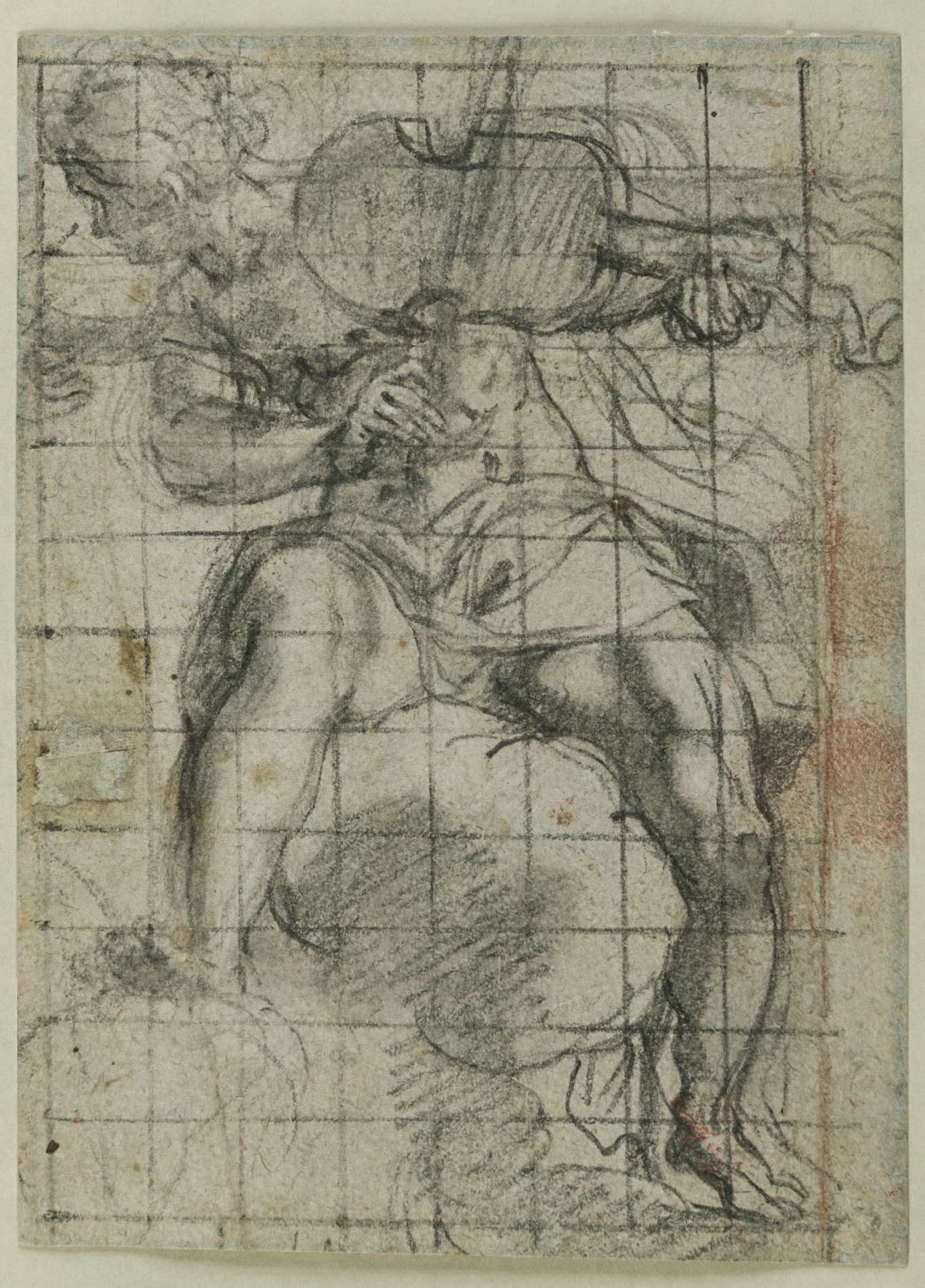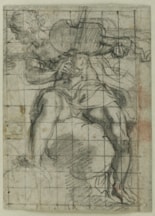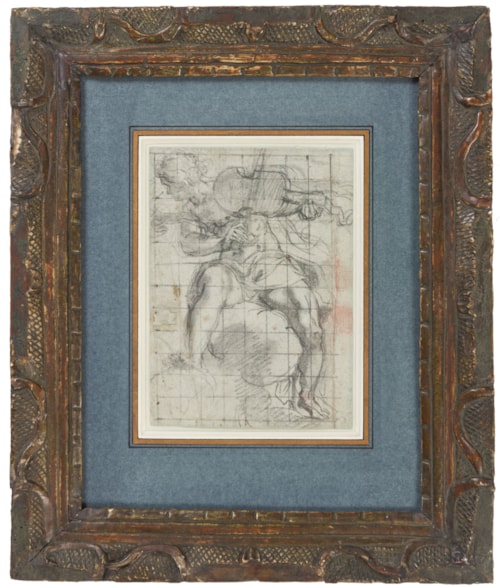Andrea LILIO
(Ancona c.1555 - Ascoli Piceno after 1635)
An Angel Seated on a Cloud and Playing the Violin
Black chalk, with touches of red chalk, squared for transfer in black chalk, on blue paper.
158 x 114 mm. (6 1/4 x 4 1/2 in.)
158 x 114 mm. (6 1/4 x 4 1/2 in.)
Fewer than eighty drawings by Andrea Lilio are known today, and of those only a handful have been connected with his extant paintings or frescoes. This fine, squared drawing – described by the Lilio scholar Massimo Pulini as ‘one of the most beautiful recent additions to the catalogue of [drawings by] the artist’ – is a preparatory study for a now-dismembered monumental altarpiece of The Virgin Crowning Saint Nicholas of Tolentino, signed and dated 1598. Painted for the church of Sant’Agostino in Ancona, the remnants of the painting are today, in four fragments, in the collection of the Pinacoteca Civica there. One of these fragments depicts a panoramic view of Ancona from the sea, with part of the feet of a seated figure visible in the clouds at the upper right, which precisely match those of the angel in the present sheet. This music-making angel was therefore depicted, playing his violin in the skies above the city, in the upper part of the altarpiece. While the entire composition of The Virgin Crowning Saint Nicholas of Tolentino is difficult to determine from the few sections of the canvas that survive, the scale of these fragments – one of which depicts an angel playing a lute - indicates that the altarpiece must have been among the largest canvases to have been painted by the artist.
The present sheet can be compared stylistically with a squared drawing of three music-making angels by Lilio in the Louvre. Likewise in black chalk on blue paper, the Louvre drawing is the study for the upper part of an altarpiece of Saints John the Baptist, Francis of Assisi, Bernardino of Siena and Paul Adoring the Cross, painted in the mid-1590s for the church of San Francesco in Ancona and now in the Pinacoteca Civica there. Indeed, the pose of the angel in this drawing is similar to that of the central angel playing a violin in the Ancona painting.
Among other stylistically comparable drawings by Lilio is a study in black chalk of a Dead Christ in the Museum Boijmans-van Beuningen in Rotterdam, which is preparatory for a Pietà with Saints, signed and dated 1596, that is today in the Pinacoteca Civica in Bagnacavallo, and a squared drawing of Saint Irene and Others Tending to the Wounds of Saint Sebastian in the J. Paul Getty Museum in Los Angeles.
Likewise comparable is a drawing of Saint Peter of Alcántara Giving Communion to Saint Teresa of Avila, in black chalk on blue paper, in the Biblioteca Nacional de España in Madrid, and a squared study of A Seated Evangelist in the same technique, in the Teyler Museum in Haarlem, as well as an Assumption of the Virgin, in the Museo del Prado in Madrid, which is a compositional study for an altarpiece of 1604 in a church in the coastal town of Numana, south of Ancona.
The present sheet was once part of the collection of the art historian, museum curator, patron and cultural broadcaster Sir Kenneth Clark, later Lord Clark of Saltwood (1903-1983). Clark, who served as Director of the National Gallery and Keeper of the King’s Pictures between 1934 and 1945, and later as chairman of the Arts Council, began collecting while a student at Oxford, and eventually assembled a small but choice group of Old Master and British drawings, as well as paintings, sculptures, illuminated miniatures and works of art dating from the Renaissance to the 1940s.
The present sheet can be compared stylistically with a squared drawing of three music-making angels by Lilio in the Louvre. Likewise in black chalk on blue paper, the Louvre drawing is the study for the upper part of an altarpiece of Saints John the Baptist, Francis of Assisi, Bernardino of Siena and Paul Adoring the Cross, painted in the mid-1590s for the church of San Francesco in Ancona and now in the Pinacoteca Civica there. Indeed, the pose of the angel in this drawing is similar to that of the central angel playing a violin in the Ancona painting.
Among other stylistically comparable drawings by Lilio is a study in black chalk of a Dead Christ in the Museum Boijmans-van Beuningen in Rotterdam, which is preparatory for a Pietà with Saints, signed and dated 1596, that is today in the Pinacoteca Civica in Bagnacavallo, and a squared drawing of Saint Irene and Others Tending to the Wounds of Saint Sebastian in the J. Paul Getty Museum in Los Angeles.
Likewise comparable is a drawing of Saint Peter of Alcántara Giving Communion to Saint Teresa of Avila, in black chalk on blue paper, in the Biblioteca Nacional de España in Madrid, and a squared study of A Seated Evangelist in the same technique, in the Teyler Museum in Haarlem, as well as an Assumption of the Virgin, in the Museo del Prado in Madrid, which is a compositional study for an altarpiece of 1604 in a church in the coastal town of Numana, south of Ancona.
The present sheet was once part of the collection of the art historian, museum curator, patron and cultural broadcaster Sir Kenneth Clark, later Lord Clark of Saltwood (1903-1983). Clark, who served as Director of the National Gallery and Keeper of the King’s Pictures between 1934 and 1945, and later as chairman of the Arts Council, began collecting while a student at Oxford, and eventually assembled a small but choice group of Old Master and British drawings, as well as paintings, sculptures, illuminated miniatures and works of art dating from the Renaissance to the 1940s.
Born in the Marchigian town of Ancona, the late Mannerist painter Andrea Lilio (sometimes Lilli) remains little recorded in contemporary documents. He is known to have been in Rome as a young man, labouring under the supervision of Cesare Nebbia on several fresco decorations commissioned by Pope Sixtus V in the 1580s. He seems to have spent much of his early career in Rome, where he also worked for Pope Clement VIII and contributed to the decoration of the Library, the Scala Santa and the apartments of Sixtus V in the Vatican. Elsewhere in Rome, Lilio painted frescoes in the nave of Santa Maria Maggiore and was active in the churches of San Giovanni in Laterano, San Francesco a Ripa, San Girolamo degli Schiavoni and the Gesù. To the early influence of the painter Ferraù Fenzoni, who was active in Rome at the same time, was added that of the Sienese artist Ventura Salimbeni and the Marchigian Antonio Viviani. In 1596 Lilio was admitted into the Accademia di San Luca in Rome, and his name appears in its records until 1601, and then again from 1613 onwards.
The artist returned several times to Ancona, where he painted a number of important works for local churches, as well as, in 1598, the temporary decorations for the entry of Pope Clement VIII into the city. Lilio was active elsewhere in the Marche, although he seems to have always maintained a studio in Rome. In 1613 he painted a Madonna of Loreto with Saints for the church of San Francesco alle Scale in Ancona. Late in his career he also created a number of designs for allegorical prints, commissioned by some of the leading noble families in Rome. Lilio’s last known dated painting is an altarpiece of The Crucifixion, painted in 1631 for the church of San Giovanni Battista in Ancona. The date of the artist’s death is unknown, although the contemporary painter and art historian Giovanni Baglione noted that he died in Ascoli Piceno while working on a project that was left unfinished; these are presumably the lunette frescoes of scenes from the life of Saint Benedict in the cloister of the church of Sant’Angelo Magno, which were executed sometime in the 1630s.
The artist returned several times to Ancona, where he painted a number of important works for local churches, as well as, in 1598, the temporary decorations for the entry of Pope Clement VIII into the city. Lilio was active elsewhere in the Marche, although he seems to have always maintained a studio in Rome. In 1613 he painted a Madonna of Loreto with Saints for the church of San Francesco alle Scale in Ancona. Late in his career he also created a number of designs for allegorical prints, commissioned by some of the leading noble families in Rome. Lilio’s last known dated painting is an altarpiece of The Crucifixion, painted in 1631 for the church of San Giovanni Battista in Ancona. The date of the artist’s death is unknown, although the contemporary painter and art historian Giovanni Baglione noted that he died in Ascoli Piceno while working on a project that was left unfinished; these are presumably the lunette frescoes of scenes from the life of Saint Benedict in the cloister of the church of Sant’Angelo Magno, which were executed sometime in the 1630s.
Provenance
An indistinct collector’s mark(?) stamped in red ink at the lower right
Sir Kenneth Clark, Lord Clark of Saltwood, London and Saltwood Castle, Kent
His posthumous sale, London, Sotheby’s, 5 July 1984, lot 168
Anonymous sale, London, Sotheby’s, 4 July 1988, lot 29
Private collection, Germany
Colnaghi / Katrin Bellinger, London, in 2004
Acquired in 2006 by Herbert Kasper, New York
Thence by descent.
Sir Kenneth Clark, Lord Clark of Saltwood, London and Saltwood Castle, Kent
His posthumous sale, London, Sotheby’s, 5 July 1984, lot 168
Anonymous sale, London, Sotheby’s, 4 July 1988, lot 29
Private collection, Germany
Colnaghi / Katrin Bellinger, London, in 2004
Acquired in 2006 by Herbert Kasper, New York
Thence by descent.
Literature
Mario di Giampaolo, ed., Disegno italiano antico: Artisti e opere dal Quattrocento al Settecento, Milan, 1994, illustrated p.160; Mario di Giampaolo, ‘Per Andrea Lilio disegnatore e una precisazione per il Cantarini’, in Disegni marchigiani dal Cinquecento al Settecento: Atti del Convegno “Il Disegno antico nelle Marche e dalle Marche”, 1995, p.78, fig. 2, reprinted in Cristiana Garofalo, ed., Mario Di Giampaolo: Scritti sul disegno italiano 1971-2008, Florence, 2010, p.300, fig.1; Massimo Pulini, Andrea Lilio, Milan, 2003, pp.200-201, no.10, and p.158, under no.59 (‘un bellissimo e spedite studio’).
Exhibition
New York and London, Colnaghi, Master Drawings, 2004, no.10.





